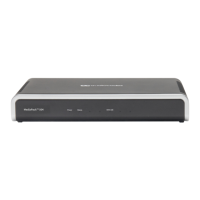SIP User's Manual 310 Document #: LTRT-65415
MediaPack Series
"GWAPP_MESSAGE_TYPE_NON_EXISTENT"
"GWAPP_MESSAGE_STATE_INCONSISTENCY"
"GWAPP_NON_EXISTENT_IE"
"GWAPP_INVALID_IE_CONTENT"
"GWAPP_MESSAGE_NOT_COMPATIBLE"
"GWAPP_RECOVERY_ON_TIMER_EXPIRY"
"GWAPP_PROTOCOL_ERROR_UNSPECIFIED"
"GWAPP_INTERWORKING_UNSPECIFIED"
"GWAPP_UKNOWN_ERROR"
"RELEASE_BECAUSE_HELD_TIMEOUT"
8.4.4 RTP Multiplexing (ThroughPacket)
The device supports a proprietary method to aggregate RTP streams from several
channels. This reduces the bandwidth overhead caused by the attached Ethernet, IP, UDP,
and RTP headers and reduces the packet/data transmission rate. This option reduces the
load on network routers and can typically save 50% (e.g., for G.723) on IP bandwidth. RTP
Multiplexing (ThroughPacket™) is accomplished by aggregating payloads from several
channels that are sent to the same destination IP address into a single IP packet.
RTP multiplexing can be applied to the entire device (see ''Configuring RTP/RTCP
Settings'' on page 100)
or to specific IP destinations using the IP Profile feature (see
''Configuring IP Profiles'' on page 122).
To enabl
e RTP Multiplexing, set the parameter RemoteBaseUDPPort to a non-zero value.
Note that the value of RemoteBaseUDPPort on the local device must equal the value of
BaseUDPPort of the remote device. The device uses these parameters to identify and
distribute the payloads from the received multiplexed IP packet to the relevant channels.
When RTP Multiplexing is used, call statistics are unavailable (since there is no RTCP
flow).
Notes:
• RTP Multiplexing must be enabled on both devices.
• When VLANs are implemented, the RTP Multiplexing mechanism is not
supported.

